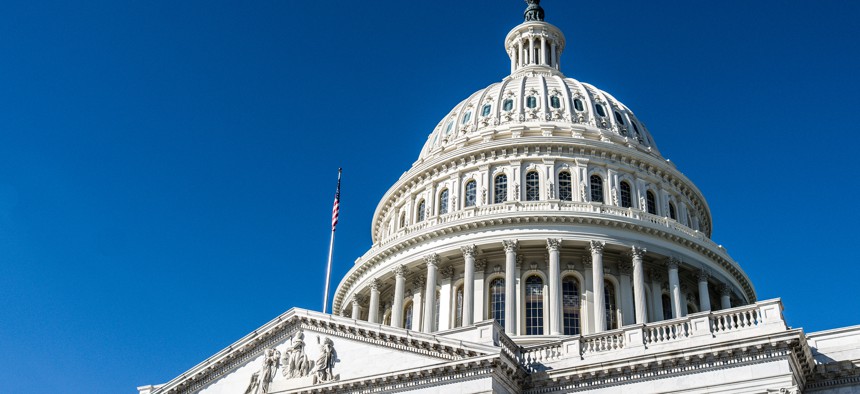House GOP Tightens Rules for Earmarks

Phil Roeder/ Getty Images
The move will likely limit future funding for state and local government projects in the areas of education, human services and workforce development, as well as for government operations.
Republicans, now in control of the U.S. House, are cutting back on the types of issues so-called earmarks can be spent on.
House Appropriations Chairwoman Kay Granger of Texas last week forbade “community project funds”—better known as earmarks—in the annual appropriations bills for the Defense, Labor, Human Services and Education departments, as well in financial services spending bills and for museums and monuments.
Conservatives praised the move, as they were critical of the billions of dollars in earmarks that were included in December’s federal spending law. Still, Granger said in a guidance to members of the House that she will continue to allow .5% of discretionary spending in the next spending bill to go toward earmarks.
In an email, a spokesman for the Appropriations Committee told Route Fifty, that in placing the restrictions, Granger is trying to focus earmark spending on “higher-quality projects for communities.”
The spokesman noted that “projects like transportation infrastructure (including airways, highways, transit, freight and passenger rail, and ports), water and sewer improvements, rural development and economic development, and public safety and law enforcement are prioritized.”
Had this limit been in place for December’s federal spending, earmarks to states, cities, counties and nonprofits would have been blocked for job training, afterschool and health care programs. Among the earmarks included in the most recent spending bill that would now be barred include $500,000 for the city of Leander, Texas, for child abuse prevention and $1.9 million to Delaware County, Pennsylvania, for a program to provide job training to people being released from prison.
David Ditch, a senior policy analyst at the Heritage Foundation’s Grover M. Hermann Center for the Federal Budget and a former staffer on the Senate budget committee, said he hoped Granger’s move would inspire Republicans in both chambers to fight what he considers to be wasteful earmarks.
In fiscal year 2022, Congress spent $9 billion for 4,970 earmarks, Ditch wrote in a recent policy paper. But in fiscal year 2023, the spending grew “dramatically” to $15.3 billion for 7,234 earmarks.
Ditch argued that in addition to going to “woke” liberal causes, such as groups that promote critical race theory, many of the earmarks use federal funds for projects that are the responsibility of local governments, “such as sidewalk improvements, public housing, museum facilities and industrial parks,” he wrote. “By offloading project costs onto Uncle Sam, these groups can shirk core responsibilities and at times obtain funding for marginal projects that would otherwise fail due to insufficient local support.”
Ditch noted that even in the types of spending where earmarks will still be allowed, a guidance issued by Granger requires a “careful vetting of projects." The heads of Appropriations subcommittees are “encouraged to reject any project that does not merit federal taxpayer funding,” the guidance said.
That, Ditch said, could mean rejecting requests by House Democrats to fund projects Republicans call “woke pork.”
Democrats, meanwhile, are disappointed in the changes. Rep. Rosa DeLauro of Connecticut, the Appropriations Committee’s top Democrat, noted in a statement to Route Fifty that even Republicans sought and received earmarks last year in the areas now being excluded.
“You should start by asking the hundreds of House Republicans who secured fiscal year 2023 projects [in the now banned areas], if they think those projects are not ‘high quality,’” she said. “These are not abstract projects funded based on a whim. These projects are created based on a demonstrated community need,” she added before ticking off a number of earmarks that would have been excluded.
In what was a boom for state and local governments, DeLauro brought back earmarks two years ago when she was chairwoman of the Appropriations Committee. Earmarks had previously been banned in 2011, with critics deriding them as wasteful government spending on projects for the friends of Congress. In restoring them, however, DeLauro made a number of changes, including allowing the money to go only to state and local governments and nonprofits, instead of to private entities.
According to a series of reports by the Government Accountability Office last September, 475 of the 478 projects funded with the $1.5 billion in grants through the Transportation Department in fiscal year 2022 went to state and local governments. Similarly, 43 of the 65 Energy Department projects funded with $103.1 million in earmarks went to state, local and tribal governments.
Under Granger’s guidance, though, earmarks are still allowed to go to these areas.
The Appropriations spokesman also noted in his email to Route Fifty that earmarks will only be allowed if they are tied to previously authorized programs with rules to make sure the money is spent properly.
The National Association of Counties in a statement did not object to the limits being placed, focusing instead on the fact that earmarks for “a wide range of projects” including "infrastructure” are still available. Though earmarks might not be allowed for labor or education programs, the organization noted that funding will be available in other areas of a spending bill.
The U.S. Conference of Mayors and the National League of Cities declined to comment on the new rules.
Since the rules apply only to the House, the restrictions wouldn’t bar state and local governments or nonprofits from vying for earmarks from their senators—although they would face more competition for the money.
Kery Murakami is a senior reporter for Route Fifty.
NEXT STORY: State & Local Roundup: The Child Tax Credit Gets a Boost






